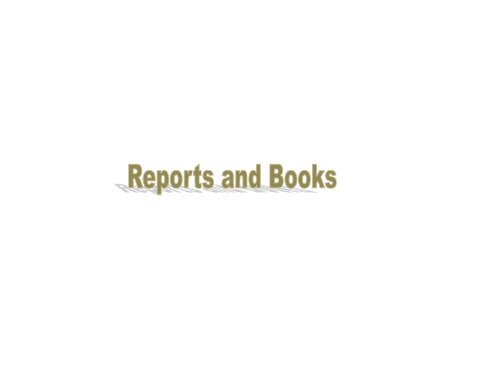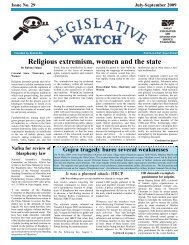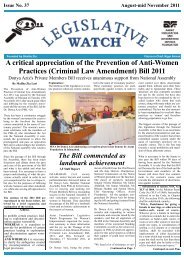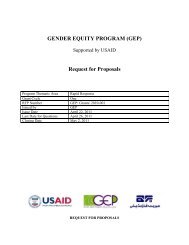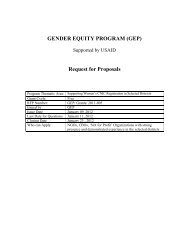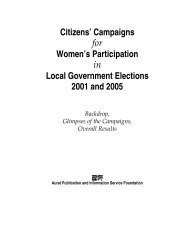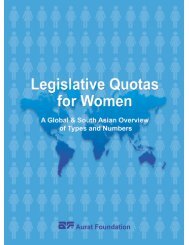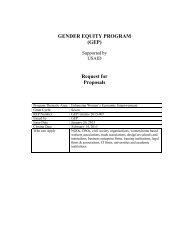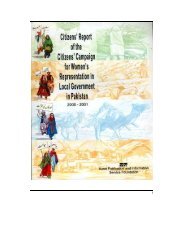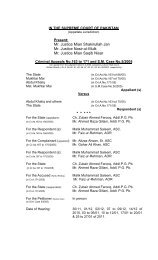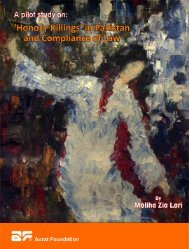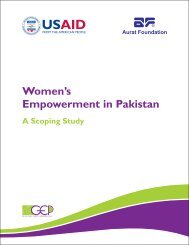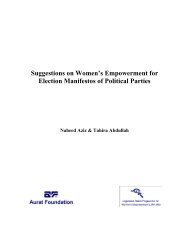About the Report - Aurat Foundation
About the Report - Aurat Foundation
About the Report - Aurat Foundation
Create successful ePaper yourself
Turn your PDF publications into a flip-book with our unique Google optimized e-Paper software.
Books and <strong>Report</strong>s<br />
CONTENTS<br />
Acknowledgement<br />
Acronyms and abbreviations<br />
Executive Summary<br />
1. Introduction<br />
2. Literature Review<br />
3. Donors and International NGOs<br />
4. Findings<br />
5. Towards Pakistan free of gender based violence<br />
6. Annexure<br />
7. Bibliography<br />
Title: Gender-based violence in Pakistan: a scooping<br />
study.<br />
Publishing place: Islamabad<br />
Publishing year: 2011<br />
Description: viii, 84 p<br />
Size: 8.5x11<br />
<strong>About</strong> <strong>the</strong> <strong>Report</strong><br />
This report provides discussion of this complex area is<br />
contextualized in <strong>the</strong> disadvantages faced by ordinary<br />
Pakistani women, with <strong>the</strong> aim to analyze <strong>the</strong> problem<br />
through a gender-sensitive and responsive lens. A<br />
qualitative research methodology was adopted for this<br />
study, which uses both primary and secondary data<br />
collection and analysis.<br />
The study approached 110 respondents from four<br />
identified groups: NGOs and international NGOs<br />
specializing in addressing gender-based violence in<br />
Pakistan; gender experts and o<strong>the</strong>r key informants in <strong>the</strong><br />
public sector, international NGOs, UN and <strong>the</strong> donor<br />
community, Pakistani print and electronic media<br />
professionals and experts on gender, women, human<br />
rights, law and legal aid, media advocacy, research and<br />
management etc.<br />
Language: English<br />
Page 1<br />
Documentation & Resource Center
Books and <strong>Report</strong>s<br />
Title: Silent Cry: Domestic Violence in NWFP<br />
Communities, baseline survey.<br />
Compiled: Zubaida Khaled<br />
Publishing place: Peshawar<br />
Publishing year: 2005<br />
Description: 256 p; tables & graphs<br />
CONTENTS<br />
Preface<br />
Background<br />
Summary analysis and conclusions<br />
Chapter 1: Baseline Survey<br />
Chapter 2: Respondent’s Profile<br />
Chapter 3: Socio-culture context and Gender Roles<br />
Chapter 4: Emerging patterns of Domestic violence<br />
Appendices<br />
List of tables<br />
<strong>About</strong> <strong>the</strong> <strong>Report</strong><br />
Talking about domestic violence is considered a<br />
trespass because <strong>the</strong>re is a very thin line between<br />
private and public spheres. In <strong>the</strong>se circumstances,<br />
where both personal and political matters are handled<br />
by <strong>the</strong> society, it is very difficult to talk about <strong>the</strong><br />
domestic violence. Discussing domestic violence is<br />
considered as peeping inside someone’s home. Carrying<br />
out a survey on this sensitive issue was not an easy job.<br />
The districts selected for <strong>the</strong> survey were Charsadda,<br />
Swabi and Swat. The criterion used for <strong>the</strong> selection of<br />
<strong>the</strong> districts was; increased number of incidence of<br />
violence reported from <strong>the</strong> selected districts, stronger<br />
adherence to traditional and conservative life style of<br />
<strong>the</strong> communities, representing particular geographic<br />
regions of <strong>the</strong> Province.<br />
Size: 8.5x11<br />
Language: English<br />
Page 2<br />
Documentation & Resource Center
Books and <strong>Report</strong>s<br />
CONTENTS<br />
Preface<br />
Acknowledgement<br />
Chapter 1: A panoramic view of a Pushtoon’s life<br />
Chapter 2: Swara <strong>the</strong> Custom<br />
Chapter 3: Swara in Practice<br />
Chapter 4: Status of Swara in Islam<br />
Chapter 5: A symposium of Scholars on Swara<br />
Chapter 6: Stark Realities<br />
Chapter 7: Spotlighting Swara by Media<br />
Chapter 8: Law Vs Tradition<br />
Conclusion<br />
Glossary<br />
Annexures<br />
<strong>About</strong> <strong>the</strong> <strong>Report</strong><br />
This research paper is an attempt to present <strong>the</strong><br />
difference between <strong>the</strong> real essence of Swara and <strong>the</strong><br />
customary practice of this Pushtoon tradition in Human<br />
Rights perspective.<br />
Title: SWARA: Women as Property.<br />
Author: Muhammad Ali Baba Khel<br />
Publishing place: Peshawar<br />
Publishing year: 2003<br />
Description: 74 p<br />
Size: 8.5x11<br />
Language: English<br />
This study provides meaning, history, origin and<br />
various definitions of Swara for <strong>the</strong> sake of conceptual<br />
clarity.<br />
The areas where this tradition has been practiced are<br />
also indicated. The stories of <strong>the</strong> people who suffered at<br />
<strong>the</strong> hands of Swara have been included to emphasis <strong>the</strong><br />
severity of situation.<br />
The literary endeavors of Pushtoon scholars, writers,<br />
short stories & dramas produced by PTV & PBC along<br />
with motion picture of Swara has been included in this<br />
research.<br />
Page 3<br />
Documentation & Resource Center
Books and <strong>Report</strong>s<br />
s<br />
CONTENTS<br />
Author’s Note<br />
Abbreviations<br />
1. Background<br />
2. Chronology of Events<br />
3. Lessons Learnt<br />
<strong>About</strong> <strong>the</strong> <strong>Report</strong><br />
This report is divided into three parts, part one includes<br />
background, explains how <strong>Aurat</strong> <strong>Foundation</strong>’s<br />
Peshawar office became involved in legal aid and crisis<br />
counseling and eventually established Mera Ghar.<br />
Title: Strom in <strong>the</strong> shelter: lesson learnt from <strong>the</strong> Mera<br />
Ghar.<br />
Author: Uzma Khan<br />
Publishing place: Peshawar<br />
Publishing year: 2006<br />
Description: 71 p; photographs<br />
Size: 6x9<br />
Language: English<br />
Part two, Chronology of Events, describes what<br />
happened during <strong>the</strong> short period from <strong>the</strong> project being<br />
funded to <strong>the</strong> shelter being closed. As attempt has been<br />
made to use external sources, especially newspaper<br />
reports, as much as possible to give a variety of views<br />
on <strong>the</strong> happenings of this critical period.<br />
Part three, Lessons Learnt, compiles <strong>the</strong> views of <strong>the</strong><br />
key players and observers and attempts to analyses <strong>the</strong><br />
events to gain an understanding of what happened and<br />
<strong>the</strong> kinds of alliances and strategies which could have<br />
helped.<br />
Documenting <strong>the</strong> experience of Mera Ghar will do more<br />
than merely create awareness about <strong>the</strong> potential<br />
problems in establishing a shelter for women in crisis.<br />
Page 4<br />
Documentation & Resource Center
Books and <strong>Report</strong>s<br />
CONTENTS<br />
Introduction<br />
Chapter 1: An overview of incidents of violence against<br />
women in Pakistan during 2008.<br />
Chapter 2: An overview of incidents of violence against<br />
women in Punjab during 2008.<br />
Chapter 3: An overview of incidents of violence against<br />
women in Sindh during 2008.<br />
Chapter 4: An overview of incidents of violence against<br />
women in NWFP during 2008.<br />
Chapter 5: An overview of incidents of violence against<br />
women in Balochistan during 2008.<br />
Chapter 2: An overview of incidents of violence against<br />
women in Federal Capital (ICT) during 2008.<br />
Appendices<br />
Title: Annual report on situation of violence against<br />
women in Pakistan 2008: collection and compilation of<br />
statistics on incidents of violence against women.<br />
Publishing place: Islamabad<br />
Publishing year: 2009<br />
Description: vii, 58 p; tables & graphs<br />
Size: 8.5x11<br />
Language: English<br />
<strong>About</strong> <strong>the</strong> <strong>Report</strong><br />
The data of violence against women contained in this<br />
report has already been shared with <strong>the</strong> media and civil<br />
society through four provincial and national quarterly<br />
report compiled during 2008.<br />
The present report is <strong>the</strong> amalgamation of <strong>the</strong>se reports<br />
in a holistic manner with brief comments on <strong>the</strong><br />
occurrence of some obvious patterns relation to<br />
violence against women in Pakistan starting from<br />
January 1 to December 31.<br />
Although, <strong>the</strong> year 2008 was particularly bad from <strong>the</strong><br />
perspective of overall violence in society, it could be<br />
described worse than previous years as far as violence<br />
against women was concerned.<br />
Page 5<br />
Documentation & Resource Center
Books and <strong>Report</strong>s<br />
CONTENTS<br />
Preface<br />
Executive Summary<br />
Section One: Context: State, Society and History<br />
Section Two: Overview of VAW Cases in Pakistan<br />
Section Three: Overview of VAW Incidents in Punjab<br />
Section Four: Overview of VAW Incidents in Sindh<br />
Section Five: Overview of VAW Incidents in Khyber<br />
Pakhtunkhwa<br />
Section Six: Overview of VAW Incidents in<br />
Balochistan<br />
Section Seven: Overview of VAW Incidents in ICT<br />
List of Tables<br />
List of Figures<br />
List of Acronyms<br />
Glossary<br />
Title: Annual report on situation of violence against<br />
women in Pakistan: a qualitative review of statistics for<br />
2009.<br />
Publishing place: Islamabad<br />
Publishing year: 2010<br />
Description: xxiv, 58 p; tables & graphs<br />
Size: 8.5x11<br />
<strong>About</strong> <strong>the</strong> <strong>Report</strong><br />
This national study is a compilation of <strong>the</strong> four regional<br />
reports put toge<strong>the</strong>r by four provinces and Islamabad<br />
capital.<br />
This is a qualitative review of statistics for violence<br />
against women in Pakistan during 2009. The reported<br />
statistics are nothing but a true copy, only larger in size,<br />
of an earlier report in this series.<br />
One purpose in collecting this data and its dissemination<br />
is to continue reminding decision-makers and<br />
stakeholders of <strong>the</strong> gravity of <strong>the</strong> VAW situation in<br />
Pakistan<br />
Language: English<br />
Page 6<br />
Documentation & Resource Center
Books and <strong>Report</strong>s<br />
CONTENTS<br />
List of Acronyms<br />
Local Glossary<br />
Global Glossary<br />
Acknowledgement<br />
Preface<br />
Executive Summary<br />
Section One: Context: State, Society and History<br />
Section Two: Overview of VAW Cases in Pakistan<br />
Section Three: Overview of VAW Incidents in Punjab<br />
Section Four: Overview of VAW Incidents in Sindh<br />
Section Five: Overview of VAW Incidents in Khyber<br />
Pakhtunkhwa<br />
Section Six: Overview of VAW Incidents in<br />
Balochistan<br />
Section Seven: Overview of VAW Incidents in<br />
Islamabad Capital Territory (ICT)<br />
Conclusion<br />
Annexure<br />
Title: Annual report on situation of violence against<br />
women in Pakistan: a qualitative review of statistics for<br />
2010.<br />
Publishing place: Islamabad<br />
Publishing year: 2011<br />
Description: xvi, 63 p; tables<br />
Size: 8.5x11<br />
<strong>About</strong> <strong>the</strong> <strong>Report</strong><br />
The present report is <strong>the</strong> third in <strong>the</strong> series Violence<br />
Against Women (VAW) in Pakistan, presenting a<br />
qualitative review of VAW statistics for <strong>the</strong> year 2010.<br />
The present report forms part of <strong>the</strong> actions undertaken<br />
by <strong>Aurat</strong> <strong>Foundation</strong> for providing momentum to <strong>the</strong><br />
efforts for advocacy, policy and law reforms for<br />
enforcement of measures in collaboration with o<strong>the</strong>r<br />
like-minded civil society organizations, groups and<br />
activists.<br />
Language: English<br />
Page 7<br />
Documentation & Resource Center
Books and <strong>Report</strong>s<br />
Title: Kari Nahi Shaheed Aurtain<br />
Edited by: Rabeea Hadi & Wasim Wahga.<br />
Publishing place: Islamabad<br />
Publishing year: 2009<br />
Description: 74 p<br />
CONTENTS<br />
Major Lacunas in <strong>the</strong> law on Honour Killing<br />
Buried in Time By Kamila Hyat<br />
Institutional Reforms for Elimination of Violence<br />
against Women in Pakistan By Naeem Mirza<br />
Declaration on <strong>the</strong> Elimination of Violence against<br />
Women.<br />
Cases of Violence against Women in Pakistan during<br />
<strong>the</strong> first three quarters of 2008 By Rabeea Hadi.<br />
Why ga<strong>the</strong>r data on violence against women? By<br />
Wasim Wagha.<br />
Islamabad Declaration on killing/burying women alive<br />
in <strong>the</strong> name of honour and o<strong>the</strong>r customary practices.<br />
Kia Tum bhi Ayesa Sochtay Ho by Farhana<br />
Is To You? = Yeh Tum Ho? By Gumnam<br />
Victim = Mazloom By Mohsin Jafri<br />
Nam Nahad Ghairat key Nam per By Khawar Ahmad.<br />
Mein Inkar Karti Hoon By Aliya Mirza<br />
Meri Neend sey Ankhein Jalti Rahein By Aliya Miraz<br />
Ayhed-e-Nou ki Awaz By Anees Haroon<br />
The Voice of Silence = Khamoshi Ka Shor By Atiya<br />
Dawood<br />
To My Daughter = Apni Baiti key Nam By Atiya<br />
Dawood<br />
Hamein Kia Karna Chahiey<br />
Mazajon mein yas agai hey hamari By Manoo Bhai<br />
Aurtoon per tashadud key khatmey ka Eilan (UNO)<br />
Tashadud key nit naiy rujhanat aur shiddat: Kiyon By<br />
Anees Haroon<br />
Size: 7x9.5<br />
Language: English & Urdu<br />
Page 8<br />
Documentation & Resource Center
Books and <strong>Report</strong>s<br />
Title: Violence Against Women: case studies from<br />
Bangladesh, Nepal and Pakistan<br />
Publishing place: Karachi<br />
Published by: City Press<br />
Publishing year: 1999<br />
Description: 94 p<br />
Size: 5.5x8.8<br />
Language: English<br />
CONTENTS<br />
Bangladesh<br />
Transgressive acts, heroic feats by Elora Halim<br />
Chowdhury<br />
Naripokkho: Fighting crimes of hate<br />
Nepal<br />
Violence against women in Nepal through culturally<br />
appropriated sexual space by Madhuri Singh<br />
Case study: Dolma, a victim of domestic violence<br />
Case study: Trafficking and domestic violence<br />
Case study: Bigamy, domestic violence and rape<br />
SAATHI: Fighting violence against women<br />
Pakistan<br />
Case study: Perwez, a victim of karo-kari by<br />
Muhammad Yaqub (AF) and Ghaffar Malik (SDS)<br />
<strong>Aurat</strong> <strong>Foundation</strong>: Advocacy and Interventions<br />
Case study: Story of Parveen Martha<br />
AGHS Legal Aid Cell: An introduction<br />
War Against Rape: An introduction<br />
Bedari: Crisis Intervention Programme<br />
<strong>About</strong> <strong>the</strong> <strong>Report</strong><br />
This book is a compilation of selected case studies<br />
shared in <strong>the</strong> Regional Workshop on Violence against<br />
Women held in Karachi from November 21- 23, 1997,<br />
organized jointly by <strong>Aurat</strong> <strong>Foundation</strong> and <strong>the</strong> Asia<br />
<strong>Foundation</strong>. The stories of gross violations of human<br />
rights and sexual abuse of women reflect <strong>the</strong> extent and<br />
<strong>the</strong> magnitude of VAW in Bangladesh, Nepal and<br />
Pakistan.<br />
Page 9<br />
Documentation & Resource Center
Books and <strong>Report</strong>s<br />
CONTENTS<br />
Acknowledgement<br />
Acronyms and abbreviations<br />
Executive Summary<br />
1. Introduction<br />
2. Literature Review<br />
3. Donors and International NGOs<br />
4. Findings<br />
5. Towards Pakistan free of gender based violence<br />
6. Annexures<br />
7. Bibliography<br />
Title: Gender-based violence in Pakistan: a scooping<br />
study.<br />
Publishing place: Islamabad<br />
Publishing year: 2011<br />
Description: viii, 84 p<br />
Size: 8.5x11<br />
<strong>About</strong> <strong>the</strong> <strong>Report</strong><br />
This report provides discussion of this complex area is<br />
contextualized in <strong>the</strong> disadvantages faced by ordinary<br />
Pakistani women, with <strong>the</strong> aim to analyze <strong>the</strong> problem<br />
through a gender-sensitive and responsive lens. A<br />
qualitative research methodology was adopted for this<br />
study, which uses both primary and secondary data<br />
collection and analysis.<br />
The study approached 110 respondents from four<br />
identified groups: NGOs and international NGOs<br />
specializing in addressing gender-based violence in<br />
Pakistan; gender experts and o<strong>the</strong>r key informants in <strong>the</strong><br />
public sector, international NGOs, UN and <strong>the</strong> donor<br />
community, Pakistani print and electronic media<br />
professionals and experts on gender, women, human<br />
rights, law and legal aid, media advocacy, research and<br />
management etc.<br />
Language: English<br />
Page 4<br />
Documentation & Resource Center


